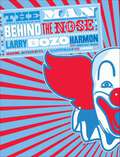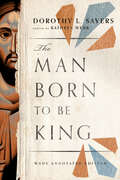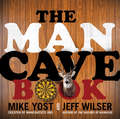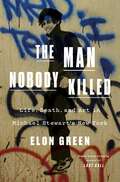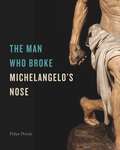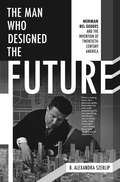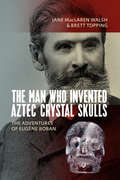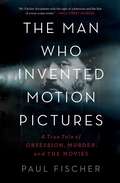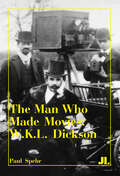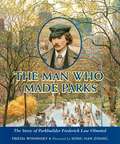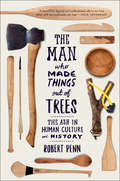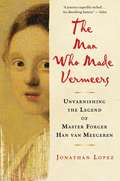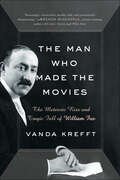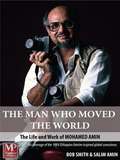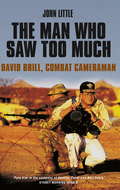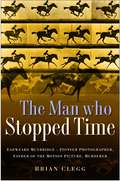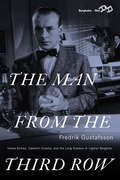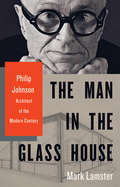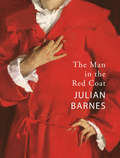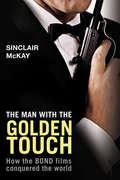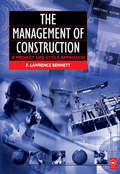- Table View
- List View
The Man Behind the Nose: Assassins, Astronauts, Cannibals, and Other Stupendous Yarns
by Larry HarmonThe Man Behind the Nose is the autobiography of the man who was Bozo. For 50 years Larry Harmon was the face—and the nose—of Bozo the Clown, the most well-known, beloved clown of them all, the precursor for every successful modern-day harlequin to come, from Ronald McDonald to Krusty. A warm, surprising, and endlessly entertaining life story filled to the brim with “Assassins, Astronauts, Cannibals, and Other Stupendous Tales,” The Man Behind the Nose is a rollicking ride through the world of a true American icon in greasepaint.
The Man Born to Be King: Wade Annotated Edition
by Dorothy L. SayersFrom December 1941 until October 1942, the BBC broadcast a series of radio dramas written by Dorothy L. Sayers.Noted for their use of colloquial English as part of Sayers's effort to bring the Gospels to life in a new way for listeners, the plays were both controversial and incredibly successful, bolstering the morale of the country during the war. They were subsequently published in 1943, and they stand among Sayers's most beloved works to this day.In this new critical and annotated edition, scholar Kathryn Wehr brings fresh insights to the plays, their background, Sayers's creative process, and the ongoing significance of the life of Christ today. Listen again, or for the first time, to the story of the man who was born to be—and still is—king.
The Man Cave Book
by Michael H. Yost Jeff WilserWhat separates the men from the boys? The Man Cave. Boyhood Fort Man Cave Who's allowed Not girls-they have cooties Not women-they have authority Primary materials used in construction Wood, stuff your mom doesn't want Particleboard, stuff your wife doesn't want Key activities inside Goofing around, avoiding responsibility Goofing around, avoiding responsibility Peak periods of use After school, weekends After work, weekends Slumber parties with buddies? Yes No Food and beverages consumed Soda and unhealthy snacks Beer and unhealthy snacks Spend the night inside? Not as a habit, but it's been known to happen Not as a habit, but it's been known to happen Money spent on space As little as possible As much as possible Is this a phase you will outgrow? Yes No The Man Cave Book is a tribute to great and glorious man spaces and the craftsmen behind them. Complete with instructions and insights into creating your own unique refuge and shrine to beer, sports, and everything else that's right with the world, this is an essential manual for any man cave enthusiast.
The Man Nobody Killed: Life, Death, and Art in Michael Stewart's New York
by Elon GreenThe first comprehensive book about Michael Stewart, the young Black artist and model who was the victim of a fatal assault by police in 1983, from Elon Green, the Edgar Award-winning author of Last Call.At twenty-five years old, Michael Stewart was a young Black aspiring artist, deejay, and model, looking to make a name for himself in the vibrant downtown art scene of the early 1980’s New York City. On September 15, 1983, he was brutally beaten by New York City Transit Authority police for allegedly tagging a 14th Street subway station wall.Witnesses reported officers beating him with billy clubs and choking him with a nightstick. Stewart arrived at Bellevue Hospital hog-tied with no heartbeat and died after thirteen days in a coma. This was, at that point, the most widely noticed act of police brutality in the city's history. The Man Nobody Killed recounts the cultural impact of Michael Stewart’s life and death.The Stewart case quickly catalyzed movements across multiple communities. It became a rallying cry, taken up by artists and singers including Madonna, Keith Haring, Spike Lee, and Jean-Michel Basquiat, tabloid legends such as Jimmy Breslin and Murray Kempton, and the pioneering local news reporter, Gabe Pressman. The Stewart family and the downtown arts community of 1980s New York demanded justice for Michael, leading to multiple investigations into the circumstances of his wrongful death.Elon Green, the Edgar Award–winning author of Last Call, presents the first comprehensive narrative account of Michael Stewart's life and killing, the subsequent court proceedings, and the artistic aftermath. In the vein of The Short and Tragic Life of Robert Peace and His Name is George Floyd, Green brings us the story of a promising life cut short and a vivid snapshot of the world surrounding this loss. A tragedy set in stark contrast against the hope, activism, and creativity of the 1980’s New York City art scene, The Man Nobody Killed serves as a poignant reminder of recurring horrors in American history and explores how, and for whom, the justice system fails.
The Man Who Broke Michelangelo’s Nose
by Felipe PeredaRenaissance sculptor Pietro Torrigiano has long held a place in the public imagination as the man who broke Michelangelo’s nose. Indeed, he is known more for that story than for his impressive prowess as an artist. This engagingly written and deeply researched study by Felipe Pereda, a leading expert in the field, teases apart legend and history and reconstructs Torrigiano’s work as an artist. Torrigiano was, in fact, one of the most fascinating characters of the sixteenth century. After fighting in the Italian wars under Cesare Borgia, the Florentine artist traveled across four countries, working for such patrons as Margaret of Austria in the Netherlands and the Tudors in England. Toriggiano later went to Spain, where he died in prison, accused of heresy by the Inquisition for breaking a sculpture of the Virgin and Child that he had made with his own hands. In the course of his travels, Torrigiano played a crucial role in the dissemination of the style and the techniques that he learned in Florence, and he interacted with local artisanal traditions and craftsmen, developing a singular terracotta modeling technique that is both a response to the authority of Michelangelo and a unique testimony to artists’ mobility in the period.As Pereda shows, Torrigiano’s life and work constitute an ideal example to rethink the geography of Renaissance art, challenging us to reconsider the model that still sees the Renaissance as expanding from an Italian center into the western periphery.
The Man Who Designed the Future: Norman Bel Geddes and the Invention of Twentieth-Century America
by B. Alexandra SzerlipBefore there was Steve Jobs, there was Norman Bel Geddes. A ninth-grade dropout who found himself at the center of the worlds of industry, advertising, theater, and even gaming, Bel Geddes designed everything from the first all-weather stadium, to Manhattan's most exclusive nightclub, to Futurama, the prescient 1939 exhibit that envisioned how America would look in the not-too-distant 60s. In The Man Who Designed the Future, B. Alexandra Szerlip reveals precisely how central Bel Geddes was to the history of American innovation. He presided over a moment in which theater became immersive, function merged with form, and people became consumers. A polymath with humble Midwestern origins, Bel Geddes’ visionary career would launch him into social circles with the Algonquin roundtable members, stars of stage and screen, and titans of industry. Light on its feet but absolutely authoritative, this first major biography is a must for anyone who wants to know how America came to look the way it did.
The Man Who Heard Voices
by Michael BambergerNow in paperback, a behind-the-scenes look at the groundbreaking filmmaker M. Night Shyamalan In his relatively young career, M. Night Shyamalan has achieved phenomenal commercial and critical success. His films The Sixth Sense, Unbreakable, Signs, and The Villagehave grossed over $1. 5 billion and reinvented the thriller genre. Because Shyamalan has worked outside of the Hollywood system, however, his filmmaking habits and personality have remained largely unknown. But reporter Michael Bamberger obtained unprecedented access to Shyamalan during the tumultuous production of his film Lady in the Water, and in The Man Who Heard Voicesexposes the struggles and triumphs of this modern-day Hitchcock at work. From revising the screenplay to shooting on location and evaluating the crucial initial test screening, The Man Who Heard Voicestracks all stages in the life of Shyamalan's film. Bamberger delves into Shyamalan's relationship with the actors and the studio (he moved from Disney to Warner Bros. for this film) while also profiling various players on set. The result is a fascinating insider portrait of creative genius-and the real-life story behind a Hollywood thriller.
The Man Who Invented Aztec Crystal Skulls: The Adventures of Eugène Boban
by Jane MacLaren Walsh Brett ToppingEugène Boban began life in humble circumstances in Paris, traveled to the California Gold Rush, and later became a recognized authority on pre-Columbian cultures. He also invented an entire category of archaeological artifact: the Aztec crystal skull. By his own admission, he successfully “palmed off” a number of these crystal skulls on the curators of Europe’s leading museums. How could that happen, and who was this man? Detailed are the travels, self-education, and archaeological explorations of Eugène Boban; this book also explores the circumstances that allowed him to sell fakes to museums that would remain undetected for over a century.
The Man Who Invented Motion Pictures: A True Tale of Obsession, Murder, and the Movies
by Paul FischerOne of the New York Times Best True Crime of 2022 A &“spellbinding, thriller-like&” (Shelf Awareness) history about the invention of the motion picture and the mysterious, forgotten man behind it—detailing his life, work, disappearance, and legacy.The year is 1888, and Louis Le Prince is finally testing his &“taker&” or &“receiver&” device for his family on the front lawn. The device is meant to capture ten to twelve images per second on film, creating a reproduction of reality that can be replayed as many times as desired. In an otherwise separate and detached world, occurrences from one end of the globe could now be viewable with only a few days delay on the other side of the world. No human experience—from the most mundane to the most momentous—would need to be lost to history. In 1890, Le Prince was granted patents in four countries ahead of other inventors who were rushing to accomplish the same task. But just weeks before unveiling his invention to the world, he mysteriously disappeared and was never seen or heard from again. Three and half years later, Thomas Edison, Le Prince&’s rival, made the device public, claiming to have invented it himself. And the man who had dedicated his life to preserving memories was himself lost to history—until now. The Man Who Invented Motion Pictures pulls back the curtain and presents a &“passionate, detailed defense of Louis Le Prince…unfurled with all the cliffhangers and red herrings of a scripted melodrama&” (The New York Times Book Review). This &“fascinating, informative, skillfully articulated narrative&” (Kirkus Reviews, starred review) presents the never-before-told history of the motion picture and sheds light on the unsolved mystery of Le Prince&’s disappearance.
The Man Who Loved Books Too Much: The True Story of a Thief, a Detective, and a World of Literary Obsession
by Allison Hoover BartlettThis is the story of John Gilkey, a man who repeatedly stole rare books, and the journalist who tells of, and gets caught up in, his exploits.
The Man Who Made Movies: W.K.L. Dickson
by Paul SpehrThe story of W.K.L. Dickson—assistant to Edison, inventor, and key figure in early cinematography: “Valuable and comprehensive.” —Communication Booknotes QuarterlyW.K.L. Dickson was Thomas Edison’s assistant in charge of the experimentation that led to the Kinetoscope and Kinetograph—the first commercially successful moving image machines. In 1891–1892, he established what we know today as the 35mm format. Dickson also designed the Black Maria film studio and facilities to develop and print film, and supervised production of more than one hundred films for Edison.After leaving Edison, he became a founding member of the American Mutoscope Company, which later became the American Mutoscope & Biograph, then Biograph. In 1897, he went to England to set up the European branch of the company. Over the course of his career, Dickson made between five hundred and seven hundred films, which are studied today by scholars of the early cinema. This well-illustrated book offers a window onto early film history from the perspective of Dickson’s own oeuvre.
The Man Who Made Parks: The Story Of Parkbuilder Frederick Law Olmsted
by Frieda Wishinsky Song Nan ZhangWhen the great cities of North America were being developed, there was little thought to creating “green spaces. ” Frederick Law Olmsted combined his childhood love for nature with the structured beauty of the great parks of London and Paris to turn a neglected, swampy area into one of the most acclaimed parks in North America: Central Park in New York City.
The Man Who Made Things Out of Trees
by Robert PennThe story of how one man cut down a single tree to see how many things could be made from it.Out of all the trees in the world, the ash is most closely bound up with who we are: the tree we have made the greatest and most varied use of over the course of human history. One frigid winter morning, Robert Penn lovingly selected an ash tree and cut it down. He wanted to see how many beautiful, handmade objects could be made from it. Thus begins an adventure of craftsmanship and discovery. Penn visits the shops of modern-day woodworkers--whose expertise has been handed down through generations--and finds that ancient woodworking techniques are far from dead. He introduces artisans who create a flawless axe handle, a rugged and true wagon wheel, a deadly bow and arrow, an Olympic-grade toboggan, and many other handmade objects using their knowledge of ash's unique properties. Penn connects our daily lives back to the natural woodlands that once dominated our landscapes. Throughout his travels--from his home in Wales, across Europe, and America--Penn makes a case for the continued and better use of the ash tree as a sustainable resource and reveals some of the dire threats to our ash trees. The emerald ash borer, a voracious and destructive beetle, has killed tens of millions of ash trees across North America since 2002. Unless we are prepared to act now and better value our trees, Penn argues, the ash tree and its many magnificent contributions to mankind will become a thing of the past. This exuberant tale of nature, human ingenuity, and the pleasure of making things by hand chronicles how the urge to understand and appreciate trees still runs through us all like grain through wood.
The Man Who Made Vermeers: Unvarnishing The Legend Of Master Forger Han Van Meegeren
by Jonathan LopezIt's a story that made Dutch painter Han van Meegeren famous worldwide when it broke at the end of World War II: A lifetime of disappointment drove him to forge Vermeers, one of which he sold to Hermann Goering in mockery of the Nazis. And it's a story that's been believed ever since. Too bad it isn't true. Jonathan Lopez has drawn on never-before-seen documents from dozens of archives to write a revelatory new biography of the world's most famous forger. Neither unappreciated artist nor antifascist hero, Van Meegeren emerges as an ingenious, dyed-in-the-wool crook-a talented Mr. Ripley armed with a paintbrush. Lopez explores a network of illicit commerce that operated across Europe: Not only was Van Meegeren a key player in that high-stakes game in the 1920s and '30s, landing fakes with famous collectors such as Andrew Mellon, but he and his associates later cashed in on the Nazi occupation. The Man Who Made Vermeers is a long-overdue unvarnishing of Van Meegeren's legend and a deliciously detailed story of deceit in the art world.
The Man Who Made the Movies: The Meteoric Rise and Tragic Fall of William Fox
by Vanda KrefftThis biography of a forgotten film-industry titan with a still-famous name is both “a great American success story and a shudder-provoking cautionary tale” (The Wall Street Journal).A Huffington Post Best Film Book of the YearA major Hollywood studio still bears William Fox’s name—but the man himself has mostly been forgotten by history, even written off as a failure. This vivid biography, drawing on a decade of original research, corrects the record, explaining why Fox’s legacy is central to the history of Hollywood.Growing up in Lower East Side tenements, the eldest son of impoverished Hungarian immigrants, Fox began selling candy on the street. That entrepreneurial ambition eventually grew one small Brooklyn theater into a $300 million empire of deluxe studios and theaters that rivaled those of Adolph Zukor, Marcus Loew, and the Warner brothers, and launched stars such as Theda Bara. Amid the euphoric roaring twenties, the early movie moguls waged a fierce battle for control of their industry. A fearless risk-taker, Fox won and was hailed as a genius—until a confluence of circumstances, culminating with the 1929 stock market crash, led to his ruin.At the heart of Fox’s life was the myth of the American Dream. His story intertwines the fate of the nineteenth-century immigrants who flooded into New York, the city’s vibrant and ruthless Gilded Age history, and the birth of America’s movie industry amid the dawn of the modern era. “[The author’s] attention to detail makes for gripping storytelling.” —Publishers Weekly“Stunningly researched, lucidly told, and consistently illuminating.” —Brenda Wineapple, award–winning author of The Impeachers“Krefft captures both the culture of the origins of cinema as a business and the many fascinating personalities at play within the narrative. No longer Hollywood’s forgotten pioneer, William Fox now has the history he deserves.” —The Washington Post
The Man Who Moved the World: The Life and Work of Mohamed Amin
by Bob Smith Salim Amin Michael BuerkMohamed Amin was the most famous photo journalist in the world, making the news as often as he covered it. His coverage of the 1984 Ethiopian famine proved so compelling that it inspired a collective global conscience and became the catalyst for the greatest-ever act of giving--the "We Are the World" campaign. Unquestionably, it also saved the lives of millions of men, women and children. In a career spanning more than 30 years, Mo covered every major event in Africa and beyond, braving torture, surviving bombs and bullets to emerge as the most decorated news cameraman of all time. But his frenetic life was cut tragically short when, in November, 1996, hijackers took over an Ethiopian airliner forcing it to ditch in the Indian Ocean killing 123 passengers and crew. Mo died on his feet still negotiating with the terrorists.
The Man Who Saw Too Much: David Brill, Combat Cameraman
by John LittleThis is the story of David Brill, one of the very best of Australian cameramen - past and present. He is in the same company as Damien Parer and Neil Davis.Over the past forty years he has covered wars and disasters all over the world. He filmed the fall of Saigon. He was in Moscow during the collapse of communism. He has covered countless other conflicts and natural disasters in Asia, Africa and North and South America.He has been single-mindedly dedicated to the pursuit of his craft: to get the story, get the film - always to preserve and present the human dimension, no matter how large or mindless the conflict or event.David Brill has paid a high price for this uncompromising style. He has two failed marriages, and at times has been overcome by demons such as alcohol. This biography is also a great adventure story, a journey through war zones and various hell holes of the world. And it is an inside look at what makes some people follow a profession where their life is on the line - as a standard feature of their day.
The Man Who Stopped Time
by Brian CleggBrian Clegg tells the extraordinary story of the pioneer of photography, eccentric Victorian inventor Eadweard Muybridge. If most of us have seen Muybridge's distinctive stop-motion photographs, all of us have seen the fruit of his extraordinary technological innovation: today's cinema and television. But it is his personal life that possesses all the ingredients of a classic non-fiction best-seller: a passionately driven man struggling against the odds; dire treachery and shocking betrayal; a cast of larger-than-life characters set against a backdrop of San Francisco and the Far West in its most turbulent and dangerous era; a profusion of scientific and artistic advances and discoveries, one hotly following on another; the nervous intensity of two spectacular courtroom dramas (one pitting Muybridge against the richest man in the land and staring ruin in the face, the other sees him fighting for his life). And for the opening act, a foul murder on a dark and stormy night.
The Man from the Third Row: Hasse Ekman, Swedish Cinema and the Long Shadow of Ingmar Bergman
by Fredrik GustafssonUntil his early retirement at age 50, Hasse Ekman was one of the leading lights of Swedish cinema, an actor, writer, and director of prodigious talents. Yet today his work is virtually unknown outside of Sweden, eclipsed by the filmography of his occasional collaborator (and frequent rival) Ingmar Bergman. This comprehensive introduction—the first ever in English—follows Ekman’s career from his early days as a film journalist, through landmark films such as Girl with Hyacinths (1950), to his retirement amid exhaustion and disillusionment. Combining historical context with insightful analyses of Ekman’s styles and themes, this long overdue study considerably enriches our understanding of Swedish film history.
The Man in the Glass House: Philip Johnson, Architect of the Modern Century
by Mark LamsterWhen Philip Johnson died in 2005 at the age of 98, he was still one of the most recognizable--and influential--figures on the American cultural landscape. The first recipient of the Pritzker Prize and MoMA's founding architectural curator, Johnson made his mark as one of America's leading architects with his famous Glass House in New Caanan, CT, and his controversial AT&T Building in NYC, among many others in nearly every city in the country--but his most natural role was as a consummate power broker and shaper of public opinion.Johnson introduced European modernism--the sleek, glass-and-steel architecture that now dominates our cities--to America, and mentored generations of architects, designers, and artists to follow. He defined the era of "starchitecture" with its flamboyant buildings and celebrity designers who esteemed aesthetics and style above all other concerns. But Johnson was also a man of deep paradoxes: he was a Nazi sympathizer, a designer of synagogues, an enfant terrible into his old age, a populist, and a snob. His clients ranged from the Rockefellers to televangelists to Donald Trump.Award-winning architectural critic and biographer Mark Lamster's THE MAN IN THE GLASS HOUSE lifts the veil on Johnson's controversial and endlessly contradictory life to tell the story of a charming yet deeply flawed man. A rollercoaster tale of the perils of wealth, privilege, and ambition, this book probes the dynamics of American culture that made him so powerful, and tells the story of the built environment in modern America.
The Man in the Red Coat
by Julian BarnesThe Man Booker Prize-winning author of The Sense of an Ending takes us on a rich, witty, revelatory tour of Belle Époque Paris, via the life story of the pioneering surgeon Samuel Pozzi. IN THE SUMMER OF 1885, three Frenchmen arrived in London for a few days' shopping: a prince, a count and a commoner with an Italian name. In time, each of these men would achieve a certain level of renown, but who were they then and what was the significance of their sojourn to England? Answering these questions, Julian Barnes unfurls the stories of their lives, playing out against the backdrop of the Belle Époque in Paris. Our guide through this world is Samuel Pozzi, the society doctor, free-thinker and man of science with a famously complicated private life, and the subject of one of John Singer Sargent's greatest portraits.In this vivid tapestry of people (Henry James, Sarah Bernhardt, Oscar Wilde, Proust, James Whistler, among many others), place, and time, we see not merely an epoch of glamour and pleasure, but, surprisingly, one of violence, prejudice and nativism--with more parallels to our own age than we might imagine. The Man in the Red Coat is, at once, a fresh portrait of the Belle Époque; an illuminating look at the longstanding exchange of ideas between Britain and France; and a life of a man who lived passionately in the moment but whose ideas and achievements were far ahead of his time.
The Man with the Golden Touch
by Sinclair MckayWhen Albert R. Broccoli and Harry Saltzman set out to make what they expected to be the first of three or four movies based on the espionage novels of Ian Fleming they can hardly have dreamt that they were founding a business that would still be going strong nearly half a century later. Yet the role of James Bond, which transformed Sean Connery's career in 1962 when Dr No came out, still retained its star-making power in 2006 when Daniel Craig made his Bond debut in Casino Royale. This is the story of how, with the odd misstep along the way, the owners of the Bond franchise, Eon Productions, have contrived to keep James Bond abreast of the zeitgeist and at the top of the charts for 45 years, through 21 films featuring six Bonds, three M's, two Q's and three Moneypennies Thanks to the films, Fleming's original creation has been transformed from a black sheep of the post-war English upper classes into a figure with universal appeal, constantly evolving to keep pace with changing social and political circumstances. Having interviewed people concerned with all aspects of the films, Sinclair Mckay is ideally placed to describe how the Bond 'brand' has been managed over the years as well as to give us the inside stories of the supporting cast of Bond girls, Bond villains, Bond cars and Bond gadgetry. Sinclair Mckay, formerly assistant features editor of the Daily Telegraph, works as a freelance writer and journalist. He is also the author of A Thing of Unspeakable Horror: The History of Hammer Films, which the Guardian called 'A splendid history' and the Independent on Sunday described as 'Brisk, cheerful and enthusiastic'.
The Man with the Golden Touch: How The Bond Films Conquered the World
by Sinclair MckayWhen Albert R. Broccoli and Harry Saltzman set out to make what they expected to be the first of three or four movies based on the espionage novels of Ian Fleming they can hardly have dreamt that they were founding a business that would still be going str Yet the role of James Bond, which transformed Sean Connery’s career in 1962 when Dr No came out, still retained its star-making power in 2006 when Daniel Craig made his Bond debut in Casino Royale. This is the story of how, with the odd misstep along the way, the owners of the Bond franchise, Eon Productions, have contrived to keep James Bond abreast of the zeitgeist and at the top of the charts for 45 years, through 21 films featuring six Bonds, three M’s, two Q’s and three Moneypennies. Thanks to the films, Fleming’s original creation has been transformed from a black sheep of the post-war English upper classes into a figure with universal appeal, constantly evolving to keep pace with changing social and political circumstances. Having interviewed people concerned with all aspects of the films, Sinclair McKay is ideally placed to describe how the Bond ‘brand’ has been managed over the years as well as to give us the inside stories of the supporting cast of Bond girls, Bond villains, Bond cars and Bond gadgetry. Sinclair McKay, formerly assistant features editor of the Daily Telegraph, works as a freelance writer and journalist. He is also the author of A Thing of Unspeakable Horror: The History of Hammer Films, which the Guardian called ‘A splendid history’ and the Independent on Sunday described as ‘Brisk, cheerful and enthusiastic.’
The Man with the Golden Touch: How The Bond Films Conquered the World
by Sinclair MckayWhen Albert R. Broccoli and Harry Saltzman set out to make what they expected to be the first of three or four movies based on the espionage novels of Ian Fleming they can hardly have dreamt that they were founding a business that would still be going str Yet the role of James Bond, which transformed Sean Connery's career in 1962 when Dr No came out, still retained its star-making power in 2006 when Daniel Craig made his Bond debut in Casino Royale. This is the story of how, with the odd misstep along the way, the owners of the Bond franchise, Eon Productions, have contrived to keep James Bond abreast of the zeitgeist and at the top of the charts for 45 years, through 21 films featuring six Bonds, three M's, two Q's and three Moneypennies. Thanks to the films, Fleming's original creation has been transformed from a black sheep of the post-war English upper classes into a figure with universal appeal, constantly evolving to keep pace with changing social and political circumstances. Having interviewed people concerned with all aspects of the films, Sinclair McKay is ideally placed to describe how the Bond 'brand' has been managed over the years as well as to give us the inside stories of the supporting cast of Bond girls, Bond villains, Bond cars and Bond gadgetry. Sinclair McKay, formerly assistant features editor of the Daily Telegraph, works as a freelance writer and journalist. He is also the author of A Thing of Unspeakable Horror: The History of Hammer Films, which the Guardian called 'A splendid history' and the Independent on Sunday described as 'Brisk, cheerful and enthusiastic.'
The Management of Construction: A Project Lifecycle Approach
by F. Lawrence BennettManagement of Construction introduces all aspects of management practice to students and professionals based in the construction industry. It is also important for those involved in allied fields such as design, project development, and site monitoring and inspection. The book addresses each stage of the construction project from conception to completion, giving a perspective on the whole life cycle often missing from textbooks. The author also balances engineering concerns with the human resource and personal aspects of construction management that are so important to the successful outcome of a project.
